🍁🌲🍄🌳🔥🪵🪚🪓
🍁🌲🍄🌳 Mika's Forest School Adventure 🔥🪵🪚🪓
Day One
Contents
00: The beginning
01: Rhythm sticks
02: Collecting firewood
03: Benches
04: Hand washing station
05: Lighting the fire
06: Red dragons
07: Cutting discs
08: Making beads
09: Shaping wood
10: End of Day 1
The beginning
Excited to get to the forest I left home wearing warm clothes and a beanie, then worried slightly about the grey clouds hanging above the South Downs as I biked down to Falmer. I had packed a camping stove to cook some lunch and it rattled against a metal mug stuffed with teabags as I pedalled. I was not sure what to expect, but to be honest, I was very pleased I wasn't going in to the office.
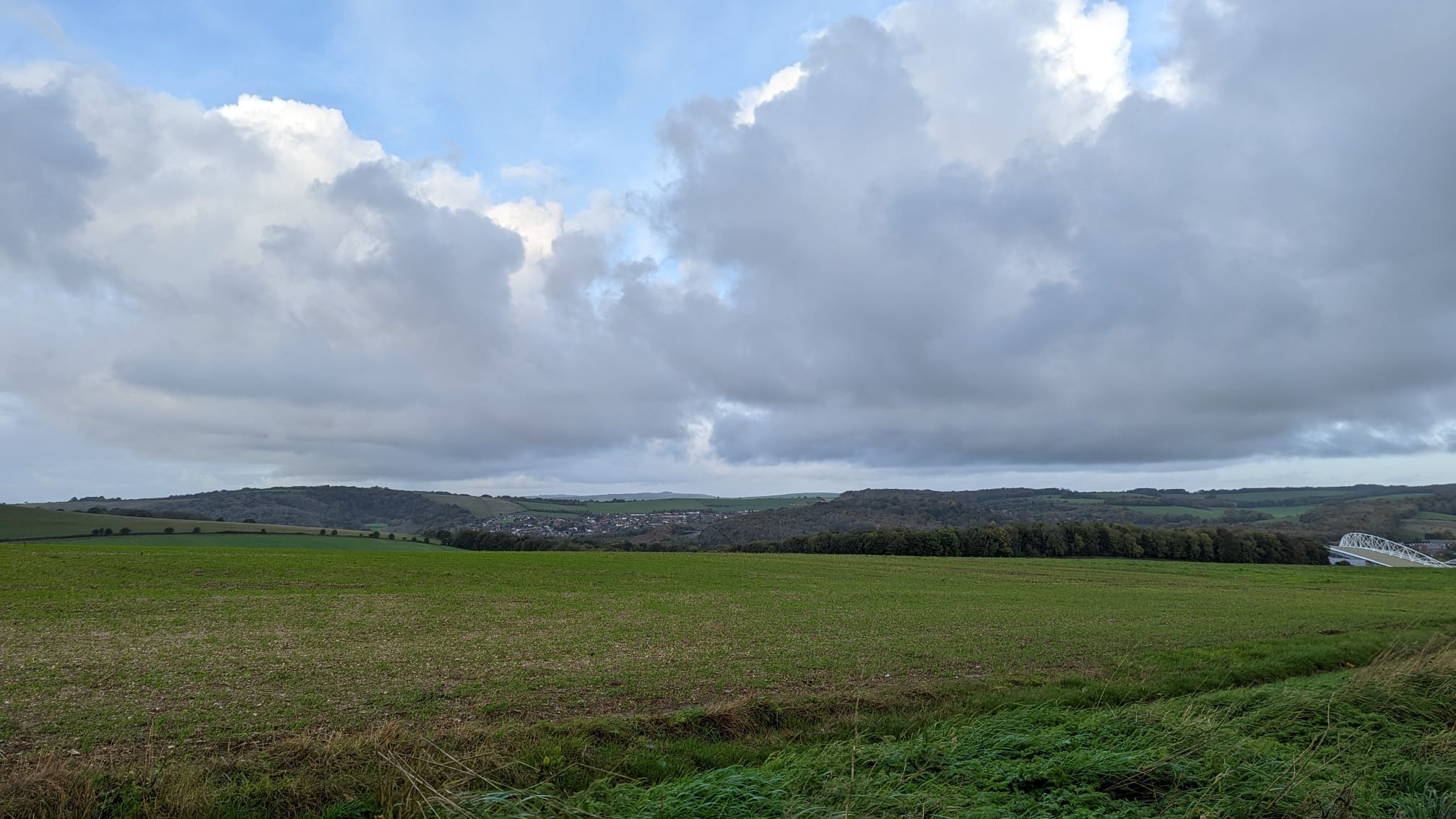
A few fellow forest initiates were waiting at the gate and as we stood chatting our numbers swelled. By the time we picked up the tools and supplies and headed through the gate there were nine intrepid students and four Forest School staff: Ro, Rn, C and N. I was very excited to start my first day of training!
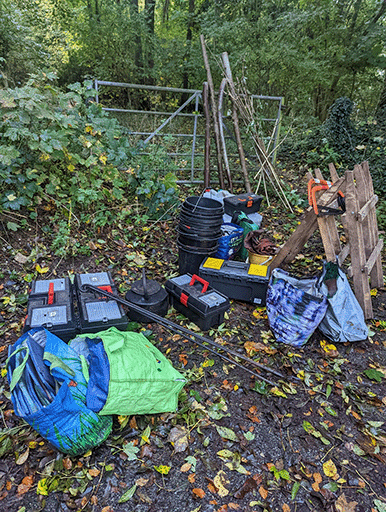
The woodlands beyond the top car park at Falmer campus don't appear to have a name. They sit nestled between Brighton and Hove Albion's stadium to the north and farmland to the south. They are flanked by Paddock Fields halls of residence to the west and more farmland to the east. A fairly well-trodden path leads from the car park and we followed it to a small clearing about 50 metres from the gate. We put the equipment down and we were ready to start!
▲ TopRhythm sticks
The rhythm stick session signals the start of Forest School.
On the first day I was surprised to find that I felt a bit nervous in this new group.
I am usually quite comfortable in groups, but I realised that often I am the one leading the group, I know what is going to happen and I am in (a certain amount of) control.
This is a different perspective and a really good reminder of what starting a new class can feel like.
I shouldn't have worried, the rhythm sticks session was nice and gentle and a really good way of learning everyone's names.
Saying hello to the people next to me multiple times and repeating their names ensured they were committed to long term memory, rather like the way some people will repeat your name three or four times when they first meet you.
"Repetition creates the strongest learning — and most learning, both implicit (like tying your laces) and explicit (multiplication tables), relies on repetition" (Schmelzer, 2022).
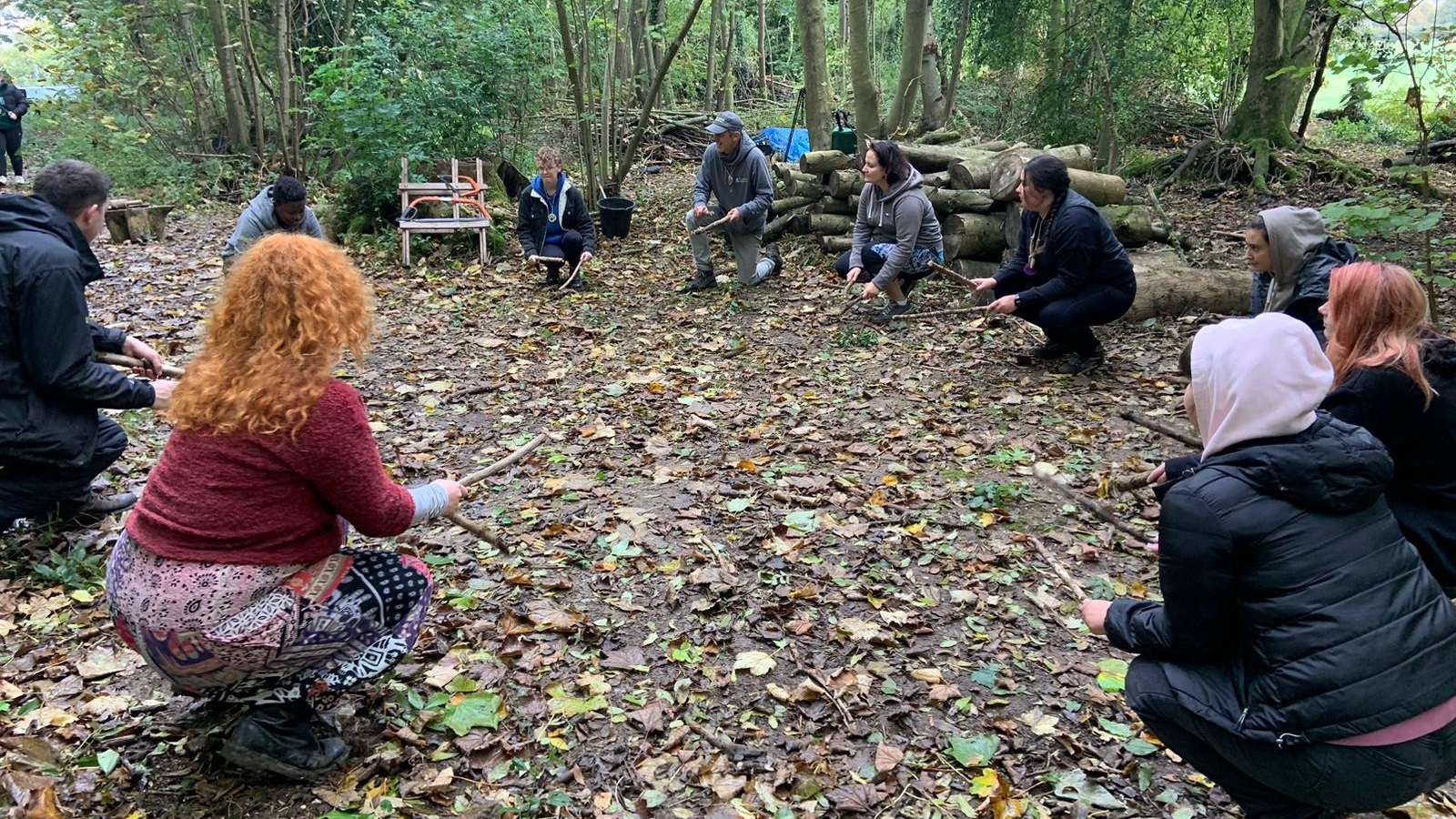
The rhythm stick session was a great introduction to some of the philosophy of Forest School.
Ro, Rn, C and N didn't explain what they were doing, they just started banging two sticks together, sticks picked up from the forest floor.
Without being asked, the group slowly started to notice what was going on, found their own sticks and joined the circle.
A choice to join in, but quite a powerful pull towards being part of the group. I found myself looking at the others that hadn't noticed, enjoying the moment they finally 'twigged'... After joining the circle, we were all immediately focused on following the rhythm.
This approach solves some of the issues that could arise with this kind of activity. If I was to hand out the sticks and explain the intention, then children are going to immediately bang them throughout any instruction. Just starting the tapping eliminates these potential problems.
The activity has a tactile element with the feel of the sticks in your hands.
There are multiple things going on: The sound of the sticks, the chanting of names, listening skills, using fine or gross motor skills to tap the sticks and move around all while trying to keep the beat and concentrate on the changes.
It's an inclusive activity that almost any child can engage with and there is some safety in the group: It doesn't matter if you are slighty out of time or make the wrong movement, there are multiple chances to redo and refine.
Collecting Firewood
A patch of forest floor was cleared a few metres from the fire circle, with enough space for four seperate piles. We started to collect various diameters of wood, but before we went too far, Rn constructed a simple frame of reference for us. The diameters were compared to various familiar items and vegetables - we set out to collect sticks like noodles, sticks like pencils, sticks like carrots and sticks like cucumbers. This simple comparison measuring system made the job of collecting firewood a lot easier. The dead branches that snap in the wind and fall, catching in the trees, made good candidates. These are referred to as 'hanging deadwood'. Wood that is dead and has dried out is best to burn. The forest floor was damp in the October rain and the sticks on the ground were noticeably wet, so these hanging branches and sticks were a better option.
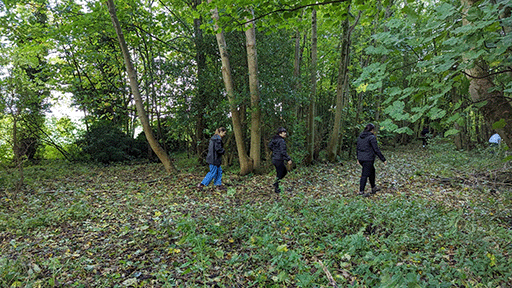
The best wood to burn is dry and dead, but it's not always easy to tell from the outside the condition of the wood. A little scratch on the bark with a key or a knife quickly shows whether the wood is suitable for burning. 'Green wood' refers to recently cut wood that still retains a large amount of moisture. It burns less cleanly and produces a lot of smoke, but also because some of the energy is used to evaporate the moisture, the fire burns at a lower temperature. A small piece of bark scratched away will reveal the green layer. Green wood is more useful for forest crafts as it is easier to saw, split or whittle. The dry wood is much harder to cut. For more serious woodwork there are extra things to consider, as green wood can crack or warp as it dries out.
▲ TopBenches
We found larger logs and stumps to form a circle around the fire. These benches are to sit on around the fire but also form a very clear distinction between inside the fire circle and outside the fire cirle.
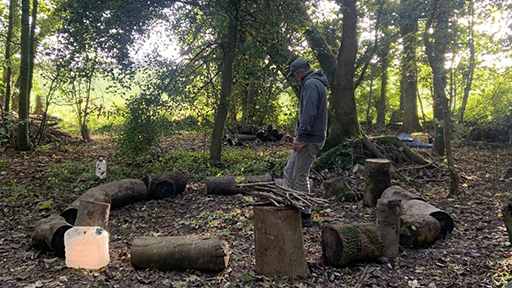
Hand-washing station
This hand-washing station was set up by tying a ridgeline to a fencepost and a sycamore tree.
There are a number of cut-off plastic milk containers with holes in the bottom hung over the line.
A couple of washing up bowls hold water and a scoop (top of a cut off milk container).
To use the station put a little soap on your hands, then scoop some water and pour it into the hanging container.
Return the scoop to the washing up bowl. The water drips out of the holes in the bottom of the hanging container allowing you to wash your hands.
I think this could be a really good starting place for discussions about recycling or repurposing and the importance of conserving resources.

This system has some similarities to the 'tip-tap' system used in many places without running water. To create a tip-tap you would set up a horizontal stick or ridgeline. Make a hole in a 5L plastic jerry can about a third of the way down the front under the spout. Tie the handle of the jerry can to the horizontal bar or line. Tie the spout to one end of a stick on the floor, leaving one end of the stick raised above the ground by the rope. By stepping on the stick the can is pulled down and water trickles from the small hole.
▲ TopLighting the fire
Before we could light the fire, we needed to build the fire. The method we used is the 'upside down fire' or 'pyramid fire'. This method involves placing the largest diameter logs side-by-side in a row forming a squarish shape, then placing the next layer of slightly smaller diameter logs on top of the first, but perpendicular to the layer beneath. This continues for as many layers as required.

This system has some similarities to the 'tip-tap' system used in many places without running water. To create a tip-tap you would set up a horizontal stick or ridgeline. Make a hole in a 5L plastic jerry can about a third of the way down the front under the spout. Tie the handle of the jerry can to the horizontal bar or line. Tie the spout to one end of a stick on the floor, leaving one end of the stick raised above the ground by the rope. By stepping on the stick the can is pulled down and water trickles from the small hole.
References
- Sussex Wildlife Trust: Forest School
- Irvine, R. (2019) Forest Craft: A child's guide to whittling in the woodland. Lewes, East Sussex: Guild of Master Craftsman Publications.
- Schmelzer, G. (2022, November 24) Understanding Learning and Memory: The Neuroscience of Repetition. Gretchen Schmelzer. http://gretchenschmelzer.com/blog-1/2015/1/11/understanding-learning-and-memory-the-neuroscience-of-repetition